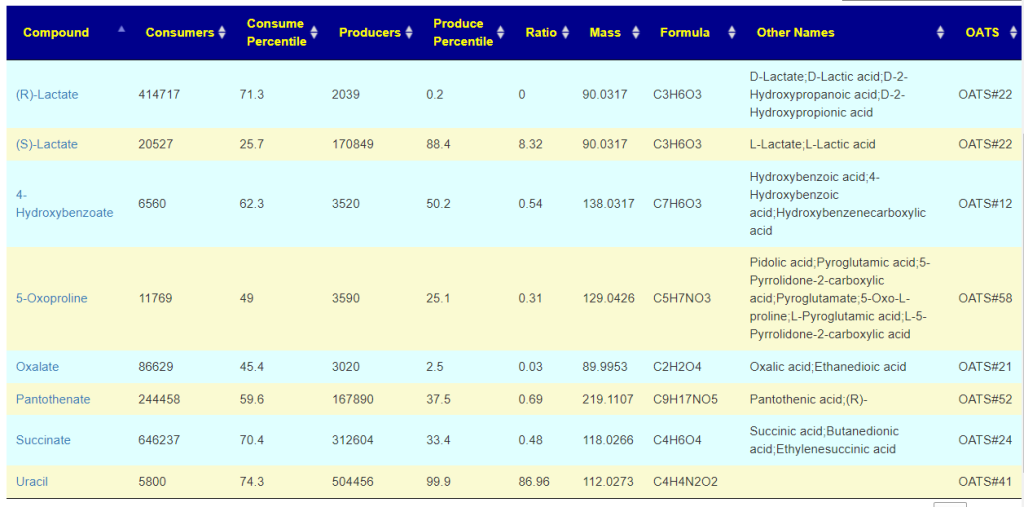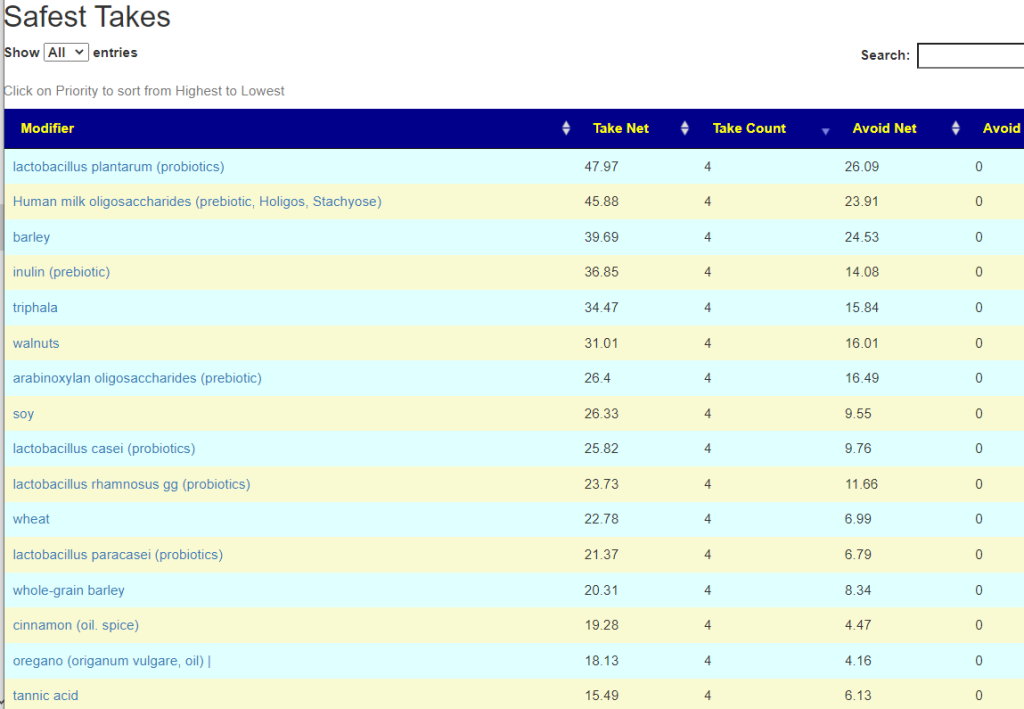Information from the reader is below
My son has ASD, with speech delay and melting down behavior, anything related gut-brain axis will be helpful. I gave 1 small spoon of custom prebiotics d- lactate free last night, he woke up crying and screaming xx but this morning I saw improvement eye contact soooo much better xx he is low on bifidobacterium and high on d-lactate.
Editor Comment: As a FYI, this was also what I dealt with as a child – Ken
Round #1: OATS Results
With the new feature of using OATS results to pick probiotics, I wanted to start with that data before looking at the microbiome. They are two separate ways of doing analysis with some overlap, but they are not the same — and getting identical results is not expected. The story of blind men descripting an elephant applies.
In general, I will look only at items flagged with H and a single item that was Low. I included the OATS number after each for reference.
- Yeast and Fungal Markers
- Items that are low are ignored (all are related to Aspergillus). Taking Aspergillus oryzae NK (strong wakamoto w) is an obvious correction, if desired.
- High items are:
- Arabinose (7)
- Carboxycitric (8) – C7H8O9 — no matches
- Bacterial Markers
- 4-Hydroxybenzoic (12)
- Oxalate Metabolites
- Oxalic (21)
- Glycolytic Cycle Metabolites
- Lactic (22)
- Mitochondrial Markers – Krebs Cycle Metabolites
- Succinic (24)
- Pyrimidine Metabolites – Folate Metabolism
- Uracil (41)
- Ketone and Fatty Acid Oxidation
- 3-Hydroxybutyric (43)
- Methylsuccinic (46)
- Nutritional Markers
- Pantothenic (B5) (52)
- Glutaric (53)
- Ascorbic (54) LOW
- Indicators of Detoxification
- Pyroglutamic (58)
- 2-Hydroxybutyric (59) – C4H8O3 – no match
- 2-Hydroxyhippuric (61) – C9H9NO4 – no match
Not every item was a match. Often for chemical formula there may be multiple matches… but no clear match (it may have the same formula, but how the atoms are connected are different).
So, with so many items, the issue of aggregation or consensus arises. I added a consolidation option to the site (you MUST be logged in to use it). It aggregates every computation request until you clear the current aggregation.

The results are shown below. The results show no clear probiotic to take when all of the above OATS results are used. If you prioritize a couple of OATS results, you may be a clearer result. On the positive side, every probiotic listed had a higher times-suggested than times not-suggested. Clostridium butyricum would be my first pick because it has the greatest positive difference and easily available.

Round #2: KEGG Suggested Probiotics
This approach does not use OATS results, rather looks for under-production of various KEGG compounds compared to other samples and looks for probiotics that produces those compounds. Note: Above we were focuses on over-production. Nothing was suggested.
I also checked KEGG AI Computed Supplements — nothing was listed.
Round #3: KEGG versus OATS
This is a bit of an lemons to watermelon comparison, but I expect someone will do it. So let us look at the results. I have added an OATS column to make life easier. We are focused on PERCENTILE. Remember that OATS reported high levels of all of these but one (OATS#54 – which there is no data on).
Remember — labs do NOT report all bacteria, nor do we know the efficiency — thus these are very rough estimates. Both Lactic Acid and Uracil are in strong agreement with OATS.

For the two items in agreement, I return to the Round 1, clear existing aggregation and try these two alone.
The results were equally not clear. The reason appears that some bacteria both consumes and produces some chemicals (often depending on the availability of other compounds). To be sure, I am refreshing my data from KEGG in the next week (I do not expect any changes … but I wish to be sure).

Round #4
Alas, we do not have KEGG provide clean, clear suggestions. That does happen with some people/samples. So we continue onwards.
Dr. Jason Hawrelak Guidance
There are a number of undesired levels:
| Bacteria Name | Analysis |
| Bacteroidia | Too High |
| Bifidobacterium | Too Low |
| Escherichia coli | Too High |
| Faecalibacterium prausnitzii | Too Low |
| Lactobacillus | Too Low |
| Methanobrevibacter | Too Low |
| Proteobacteria | Too High |
| Roseburia | Too Low |
The suggestions are below:

Kaltoft-Moltrup Range Guidance
This methods looks at the sample values that are really out of expected range when compared to 2400+ other samples. This is one of the longest list that I have seen.
| Bacteria Name | Analysis |
| Acetivibrio | Too High |
| Anaerostipes | Too Low |
| Bacteroides fragilis | Too High |
| Bacteroides uniformis | Too Low |
| Candidatus Phytoplasma | Too Low |
| Candidatus Phytoplasma prunorum | Too Low |
| Catonella | Too Low |
| Catonella morbi | Too Low |
| Dorea formicigenerans | Too Low |
| Dysgonomonadaceae | Too High |
| Dysgonomonas | Too High |
| Dysgonomonas wimpennyi | Too Low |
| Oscillospiraceae | Too High |
| Pectinatus cerevisiiphilus | Too Low |
| Peptostreptococcaceae | Too Low |
| Phocaeicola vulgatus | Too Low |
| Pseudobutyrivibrio xylanivorans | Too Low |
| Roseburia | Too Low |
Looking at the suggestions for this, and comparing to the above, I was delighted/shocked that there was a great overlap with the suggestions from Jason’s guidance — despite no shared bacteria in the picked list. This gives me confidence that these two lists feel good.

Using US Library of Medicine Autism Profile
Autism covers a wide spectrum of symptoms and causes. In general, I deprioritize this approach unless there is poor results from other approaches, but I am curious:

The result is still a longer list of selected bacteria than above.
| Bacteria Name | Analysis |
| Acidaminococcaceae | Too Low |
| Actinobacillus | Too High |
| Akkermansia | Too High |
| Akkermansia muciniphila | Too High |
| Bacteroides fragilis | Too High |
| Blautia | Too Low |
| Corynebacterium | Too Low |
| Dialister | Too High |
| Dorea | Too Low |
| Enterobacter | Too High |
| Enterobacteriaceae | Too High |
| Erysipelotrichaceae | Too Low |
| Escherichia | Too High |
| Haemophilus | Too High |
| Haemophilus parainfluenzae | Too High |
| Lachnospiraceae | Too Low |
| Lactobacillaceae | Too Low |
| Megasphaera | Too High |
| Oscillospira | Too High |
| Parabacteroides | Too High |
| Phocaeicola vulgatus | Too Low |
| Prevotella | Too High |
| Prevotellaceae | Too High |
| Roseburia | Too Low |
| Ruminococcaceae | Too High |
| Ruminococcus | Too High |
| Sarcina | Too Low |
| Staphylococcus | Too Low |
| Streptococcus | Too High |
| Veillonella | Too High |
| Veillonellaceae | Too High |
Unlike above, we actually have many to avoid with high values


Putting it all together
We have three rounds of suggestions, so should use the consensus report to combine them into one set.


Some kid friendly take away are:
- Xylitol Chewing Gum (for a child, an easy approach)
- Regular porridge with walnuts, barley, inulin with some cinnamon and whole milk.
Looking at custom prebiotics d- lactate free species we find:
- L. Rhamnosus – on Safest Take
- L. Salivarius – on Safest Take
- B. Lactis – on Safest Take
- B. Bifidum – on Safest Take
- B. Infantis – on Some Risk / Avoids
- B. Longum – on Some Risk / Avoids – but strain BB536 is on Likely Safe Takes
So, it should likely be continued — when the bottle is finished, you may wish to switch to single strains.
Remember, this is an educational post showing how to use resources on Microbiome Prescription and not intended to be medical advice in any way. Before making any changes, the changes should be reviewed by your knowledgeable medical professional. The above is based on novel artificial intelligence algorithms and approaches; as well as theoretical constructs.